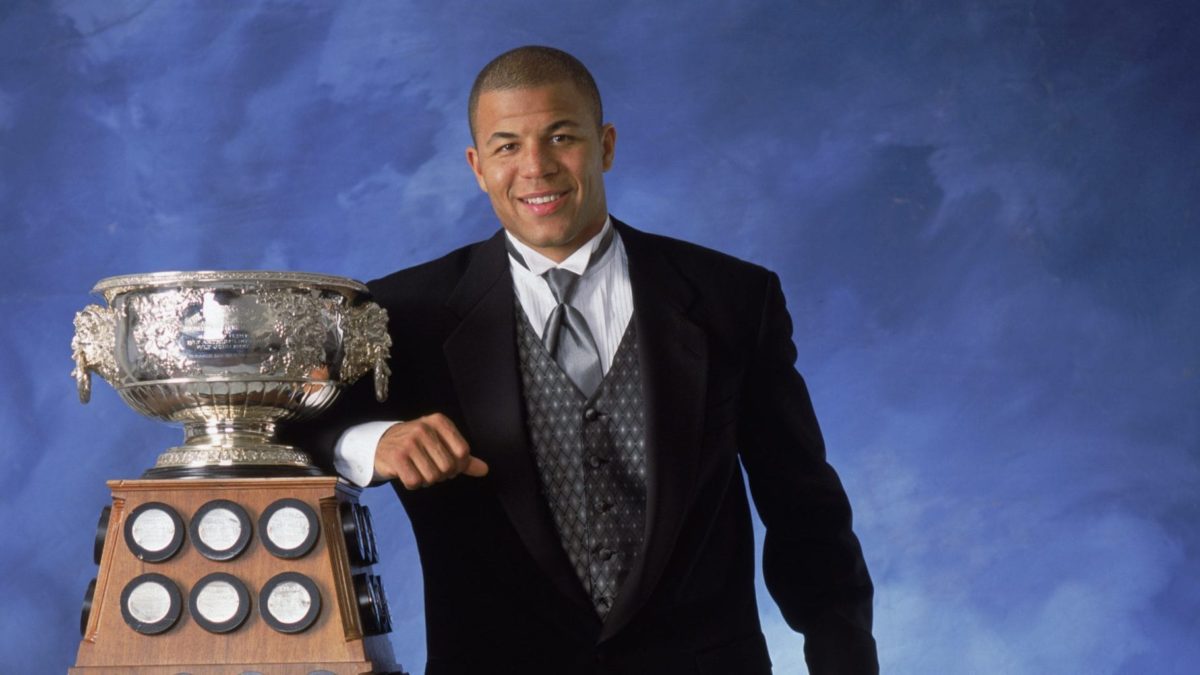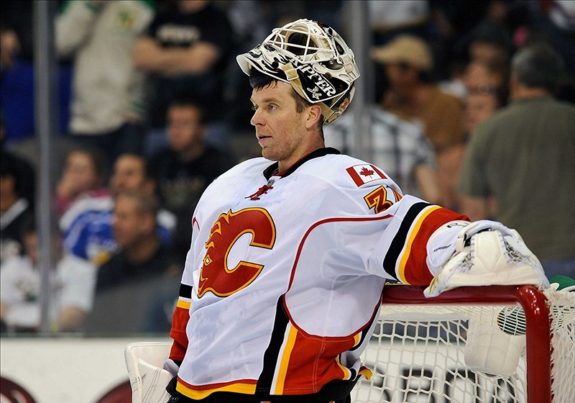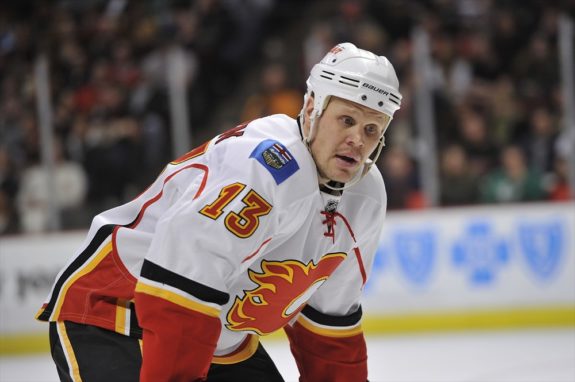The 2022-23 Calgary Flames team has certainly not performed as their fans had hoped, and are in danger of missing the postseason. After a monumental offseason that saw stars Matthew Tkachuk and Johnny Gaudreau leave for different area codes and Jonathan Huberdeau and MacKenzie Weegar join the squad, the Flames have struggled to create and maintain chemistry amongst the lineup. Huberdeau is on pace for his worst offensive season since 2013-14 and is behind only Weegar for most giveaways on the team. Meanwhile, Tkachuk is fourth in league scoring with 96 points with his team in a playoff spot while Gaudreau toils away with 65 points on the bottom-feeding Columbus Blue Jackets. The Flames as a whole simply do not look enough like the 50-win, Pacific Division-winning team of last year after arguably getting better on paper.
Related: Flames Lacking Third Period Production in 2022-23
Being that the Flames’ franchise is 51 years old, this is not the first time in its illustrious history where a team with high preseason expectations didn’t live up to to the hype. Just as there are teams that have come out of nowhere to impress fans and the hockey world alike, there are teams that make big moves and fail or plummet after perhaps showing progression a season prior. This article will provide three previous examples of Flames teams that were supposed to perform well and did not, for whatever reasons pertinent.
The 2002-03 Flames
To begin, let’s go back exactly 20 years from this season. The 2002-03 Flames were thought by many to be the team that would break the franchise out of its six-year playoff drought. After all, they had burgeoning superstar and the greatest Flame in history Jarome Iginla at their forefront. He had just had the best season of his career, scoring 52 times and totalling 96 points to win the Rocket Richard Trophy, the Art Ross trophy, and the Lester B. Pearson award. He would have also won the Hart Memorial Trophy were it not for Montreal Canadiens goalie Jose Theodore garnering more first place votes.

Iginla had lots of decent talent around him coming into the 2002-03 season: Craig Conroy had just scored a career-high 75 points, a young Marc Savard was starting to put things together offensively, and management had just swung a huge deal with the Colorado Avalanche for Chris Drury and Stephane Yelle (from ‘Drury, Yelle Traded to Flames’, LA Times, Oct. 2, 2002). Then-general manager and current TSN analyst Craig Button also swung deals for goalies Jamie McLennan and the rights to Curtis Joseph, in addition to signing Martin Gelinas in free agency.
However, things predictably didn’t work out. Savard fought with head coach Greg Gilbert until the former was moved to the Atlanta Thrashers in November. Joseph signed with the Detroit Red Wings, so the team had to lean on Roman Turek and McLennan to guard the crease. The team started the year 6-13-3-3, leading to Gilbert’s firing and an in-season replacement by none other than current Flames coach Darryl Sutter. The team went 19-16-8-1 for the remainder of the season under him. Only four players on the team registered a positive plus/minus rating, and the team only scored 186 goals in total. They ended the season with a record of 29-36-13-4 to finish 12th in the Western Conference and 17 points out of a playoff spot, also being shut out a league-high 10 times.
The 2006-07 Flames
This season was a much different story. The team was coming off of a very successful 2005-06 season in which they won the then-Northwest Division and finished third in the conference with 103 points. Legendary goaltender Miika Kiprusoff won both the Vezina and William Jennings trophies, and rookie blueliner Dion Phaneuf was a Calder Memorial Trophy nominee after scoring 20 goals and 49 points. The team was unfortunately upset by the Mighty Ducks of Anaheim in the first round of the playoffs, leaving the fans with a bitter taste but much excitement to see what the next season brought.

The hype was intensified with the Flames acquiring star forward Alex Tanguay from the Avalanche, who was coming off of back-to-back point-per-game seasons. The French-Canadian left winger was quickly signed to a three-year, $15.75 million deal before even suiting up by newly appointed GM Darryl Sutter (just a tad bit ironic). The Flames sputtered at the beginning of the season, then had a six-game win streak, then struggled again in January and never got back on track. Sutter tried to spark the team by re-acquiring Conroy from the Los Angeles Kings, but the team still struggled. They barely beat out the Avalanche in a race for the eighth seed in the Western Conference, and proceeded to lose to the juggernaut Detroit Red Wings in round one.
Iginla and Tanguay did all they could, with 94 and 81 points, respectively. The lack of team depth was seemingly the issue as well as not having a reliable option behind Kiprusoff, who appeared in a whopping 80 games including playoffs. The squad’s performances on road trips didn’t help either, where they went a dismal 13-20-8. Interestingly, this team scored 258 goals on the season, which is what the 2022-23 team is on pace for. They allowed just 226, which is 30 fewer than what the current Flames are estimated to finish at, however.
The 2011-12 Flames
The final team under our microscope are the 2011-12 Flames, who started their offseason by naming Jay Feaster general manager, and head coach Brent Sutter adding the very experienced Craig Hartsburg and Clint Malarchuk to his staff. The team also traded away the aging Robyn Regehr for Chris Butler and Paul Byron, and swapped Daymond Langkow for Lee Stempniak. They had Tanguay back after brief stints with the Montreal Canadiens and Tampa Bay Lightning, and had first-line centre Olli Jokinen again after he played a season with the New York Rangers.

Twenty-goal scorer Curtis Glencross and two-way defensemen Jay Bouwmeester and Mark Giordano were also prominent members of the team with Iginla still leading the way, now at 34 years of age. During the season, the team re-acquired Mike Camalleri from the Canadiens and claimed Blake Comeau off of waivers from the New York Islanders. Despite these facets, the team underperformed to the tune of a 37-29-16 record, missing the playoffs for the third year in a row. Their 16 overtime losses were glaring and similar to the current Flames team’s 15 as of the time of writing. Much like the Flames of today, had the 11-12 team won just half of their 16 overtime losses they would have been firmly entrenched in a playoff spot.
This team had a tough time scoring goals, with just 202 on the season. Defensively they were relatively successful, limiting opponents to a total of 226 goals on the year. This number has already been eclipsed by today’s Flames, with nine games still left to go. The season’s results left Iginla’s future up in the air; he was ultimately traded to Pittsburgh the following season. Luckily for the Flames, they used their fourth-round pick in the next draft to select a young Johnny Gaudreau.
To conclude, the Flames of 2022-23 are not the first team to disappoint the Calgary faithful and will most certainly not be the last, either. Each team is unique and carries with it its own alterations, excitement, and drama. There is still time left to make a push for the playoffs and if unsuccessful, there will be progress to build upon for 2023-24.